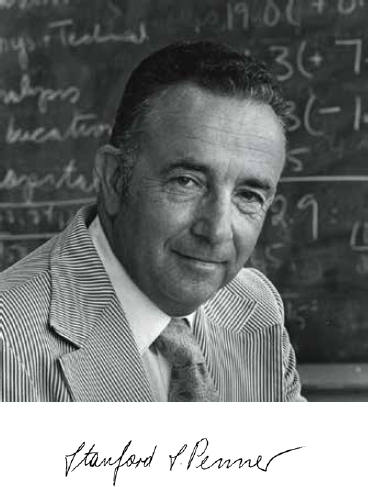This page intentionally left blank.

STANFORD S. PENNER
1921–2016
Elected in 1977
“Contributions to aerothermochemistry and its application to combustion theory, radiative heat transfer, and reentry phenomena.”
STANFORD SOLOMON PENNER is recognized worldwide for his expertise in thermophysics and his contributions to propulsion, combustion, and basic energy systems. Founder of the engineering program at the University of California, San Diego, and later founding director of the Center for Energy Research, he passed away July 15, 2016, at the age of 95.
Sol, as he was known, was born July 5, 1921, in Unna, a small town near Düsseldorf in the North Rhine–Westphalia region of Germany. He came to the United States when he was 15 years old.
After finishing high school and earning an undergraduate degree in chemistry, he joined the PhD program at the University of Wisconsin, where he worked with Farrington Daniels, at the time a well-known physicochemist. War requirements led to Sol’s involvement in solid-propellant rocket engine research and, advised by Daniels, he joined the Allegany Ballistic Laboratory in West Virginia, with responsibility for a rocket test-firing range.
At the end of the war, he returned to the University of Wisconsin and was awarded a PhD in 1946. His early propellant and radiation heat transfer studies were the beginning of long-lasting research in combustion, applied spectroscopy, and gas emissivities that extended over 60 years.
After a short postdoc at Esso Research Laboratories in Linden, New Jersey, Sol joined the Jet Propulsion Laboratory in Pasadena and then the faculty of the California Institute of Technology as a professor of jet propulsion (1950–62). At Caltech he made outstanding contributions to research on radiative heat transfer, gas spectroscopy, and chemically reacting flows in jet propulsion. During this time he also established a remarkable collaboration with Theodore von Kármán and Gregorio Millán that resulted in pioneering studies on the structure of laminar flames. Later, he extended this work by studying the burning process of solid and liquid propellants.
In 1964, after serving as the director of the Engineering and Research Division at the Institute of Defense Analyses for two years, Sol joined the UCSD faculty with a clear vision of forming an outstanding faculty who would focus on both research and training graduate students. This vision was strongly influenced by the structure and organization of the Division of Engineering at Caltech.
Sol’s initial philosophy was dominated by his belief that UCSD’s seminal engineering faculty should consist of distinguished experts who would cooperate on interdisciplinary studies without departmental boundaries while simultaneously developing their own areas of expertise. In just four years he was able to attract an impressive group of faculty in fluid and solid mechanics, systems and control engineering, structures, ocean engineering, chemical engineering, bioengineering, materials science, and aerospace engineering. He named this group AMES, for aeronautical (soon changed to aerospace) and mechanical engineering sciences. Later, it became applied mechanics and engineering sciences, maintaining the AMES acronym.
When Sol stepped down as department chair in 1968, AMES was already recognized as one of the leading engineering sciences departments in the nation. In 1971, just seven years after its creation, the National Research Council ranked it among the top ten aeronautical engineering departments in the country.
After putting engineering on a path to success, Sol founded the Center for Energy Research and continued a highly productive career in energy research and applied spectroscopy and gas emissivities.
By the time of his retirement, he had published over 320 peer-reviewed journal articles, 7 books, and 10 monographs, and edited 10 books on propulsion, energy, spectroscopy, and thermophysics. Among the impressive books he published are Quantitative Molecular Spectroscopy and Gas Emissivities (Addison-Wesley, 1959) and the excellent Chemistry Problems in Jet Propulsion (Pergamon Press, 1957). He also founded the Journal of Quantitative Spectroscopy and Radiative Transfer and was its chief editor for over 30 years.
In addition, he devoted his time to service on a number of corporate and government boards and advisory committees. For the National Research Council he chaired the Committees on Advanced Fossil Energy Technologies (1983–84) and on the International Exchange and Movement of Engineers (1987), and he was a member of the Panel for a Review of ONR Research Opportunities in Energy Conversion (1989–91), Committee on Cooperative Fossil Energy Research (1983–84), and Commission on Engineering and Technical Systems (1982–84).
Among his many national and international awards and honorary degrees are the prestigious Distinguished Associate Award from the US Department of Energy and the Edward Teller Award for the Defense of Freedom. In addition to the NAE, he was a member of the International Academy of Astronautics and a fellow of the American Academy of Arts and Sciences. In 2007 he received the NAE Founders Award “for pivotal studies on thermal radiation, propulsion, and energy systems, directing government studies, funding a university department and energy center, and training future leaders.”
While Sol dedicated his professional life to science and technology, he was always interested in art and the humanities. In fact, as a child, his ambition was to become an artist and a
poet, and he followed this early passion for the arts throughout his life. He was an avid collector of art, and over his long life accumulated an impressive collection of paintings and sculptures. Notable among them, and one he was very proud of, is a collection of Chinese hardstone carvings that has been exhibited in several museums.
Sol was married to Beverly P. Penner, an educator and school director, who passed away in 2003. They are survived by son Robert Penner of Manhattan Beach, daughter Lynn Penner of San Diego, two grandchildren, and two great-grandchildren.






